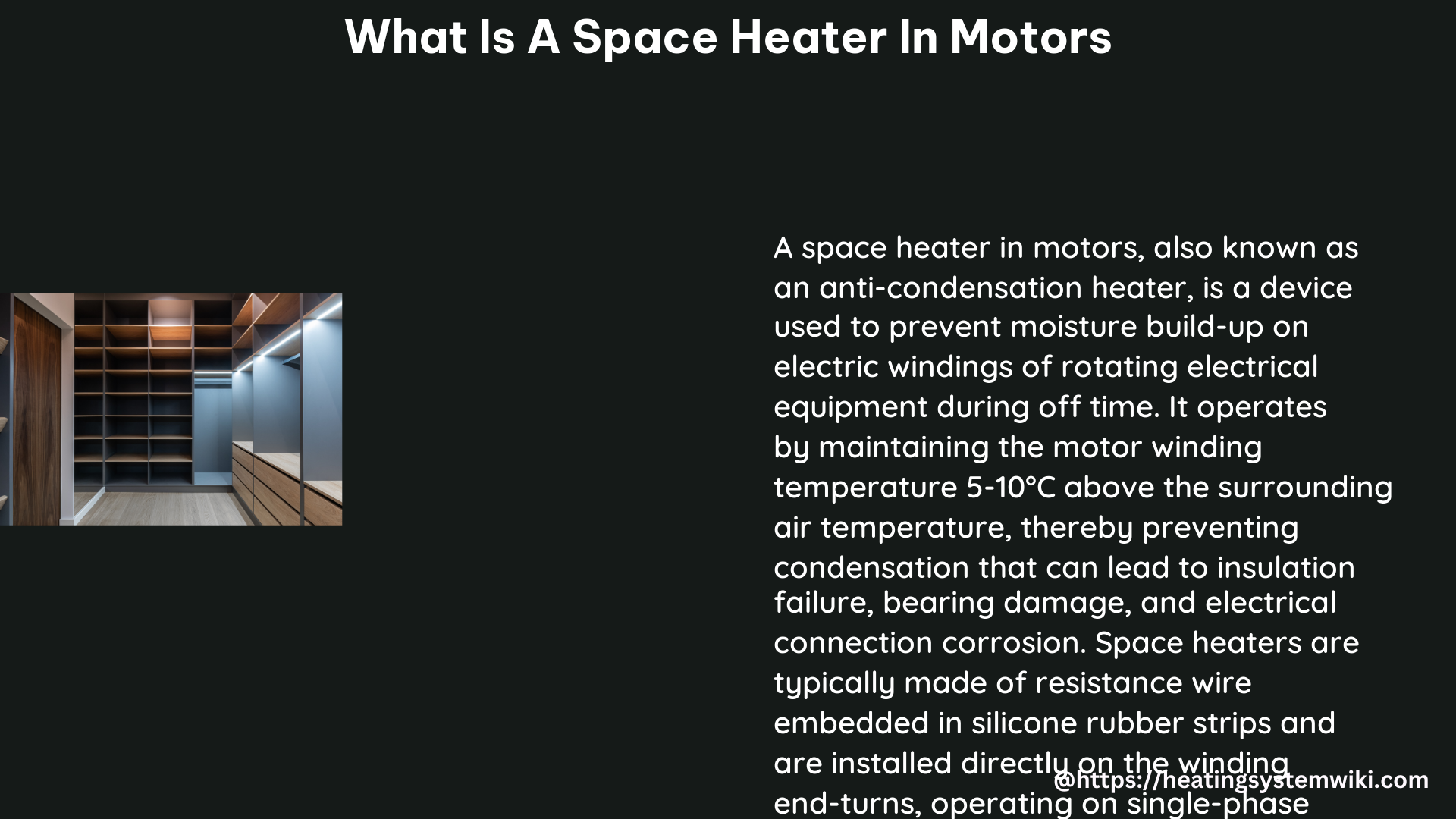Space heaters in motors are essential components that help maintain the temperature of motor windings above the surrounding ambient temperature. These heaters are embedded within the motor’s housing to prevent moisture condensation, which can lead to significant damage to the motor’s insulation, bearings, and electrical connections. This comprehensive guide will delve into the technical details, specifications, and best practices for using space heaters in motors.
Understanding the Purpose of Space Heaters in Motors
Electric motors and generators often operate in environments with high humidity, such as offshore, shipboard, and tropical locations. In these conditions, the temperature of the motor windings can drop below the dew point, leading to the formation of condensed water. This moisture can have detrimental effects on the motor’s components, including:
- Winding Insulation Degradation: Condensed water can compromise the insulation of the motor windings, leading to potential short circuits and premature failure.
- Bearing Damage: Moisture can cause corrosion and premature wear of the motor’s bearings, reducing their lifespan and reliability.
- Electrical Connection Issues: Condensation can lead to the formation of rust and oxidation on electrical connections, compromising the integrity of the motor’s electrical system.
To mitigate these issues, space heaters are installed within the motor’s housing to maintain the temperature of the windings above the dew point, preventing the formation of condensed water.
Technical Specifications of Space Heaters in Motors

The technical specifications of space heaters in motors vary depending on the manufacturer and the motor’s frame size. However, some common characteristics include:
-
Heating Wattage: The recommended heating wattage for space heaters is typically specified by the motor manufacturer and is based on the motor’s frame size. As the frame size increases, the required heating wattage also increases to maintain the necessary temperature differential.
-
Voltage: Space heaters in motors are typically designed to operate on standard AC voltages, such as 120V or 240V, depending on the motor’s electrical requirements.
-
Resistance Measurement: The proper functioning of a space heater can be verified using an ohm meter. The resistance value can be calculated using the rated wattage and voltage of the space heater, allowing for easy troubleshooting and maintenance.
-
Silicone Rubber Heaters: To reduce the failure rate of space heaters, some motor manufacturers have adopted the use of silicone rubber heaters. These heaters are designed with a large surface area and low surface watt density, making them cool enough to touch with bare hands without the risk of burns. The life expectancy of these heaters often exceeds the lifespan of the motor itself.
Selecting and Sizing Space Heaters for Motors
When selecting and sizing space heaters for motors, it is essential to consider the following factors:
-
Motor Frame Size: The recommended heating wattage for space heaters is typically specified based on the motor’s frame size. Larger frame sizes will require higher wattage heaters to maintain the necessary temperature differential.
-
Operating Environment: The ambient temperature and humidity levels of the motor’s operating environment will influence the required heating wattage. Harsher environments, such as offshore or tropical locations, may require higher wattage heaters to effectively prevent condensation.
-
Heating Capacity: The space heater’s heating capacity should be sufficient to maintain the motor windings at a temperature above the dew point, even during the coldest operating conditions.
-
Power Consumption: While ensuring adequate heating capacity, it is also important to consider the power consumption of the space heaters to optimize energy efficiency and minimize operating costs.
Installation and Maintenance of Space Heaters in Motors
Proper installation and maintenance of space heaters in motors are crucial for ensuring their long-term reliability and effectiveness. Here are some best practices:
-
Placement: Space heaters should be strategically placed within the motor’s housing to ensure even heat distribution and maximum coverage of the windings.
-
Wiring and Connections: The space heater’s wiring and electrical connections must be properly secured and protected to prevent any issues related to moisture, vibration, or mechanical stress.
-
Thermostat Integration: Many motors are equipped with thermostats that automatically control the space heater’s operation, maintaining the desired temperature range and preventing overheating.
-
Periodic Inspection: Regular inspections of the space heaters, including resistance measurements and visual checks for any signs of wear or damage, are essential for ensuring their continued reliable operation.
-
Replacement Considerations: When the space heaters reach the end of their lifespan, it is important to replace them with compatible units that meet the motor manufacturer’s specifications to maintain the desired level of protection.
By understanding the technical details and best practices for using space heaters in motors, you can ensure the long-term reliability and performance of your electric motors, even in challenging environmental conditions.
References:
- YouTube: What are Space heaters for electric motors? | Explained
- Eng-Tips: Motor space heater requirement
- Nidec: Space Heaters to Combat Motor Condensation
- Flexheaters: Motor Space Heater
- Jenkins Electric: Motor Space Heaters
